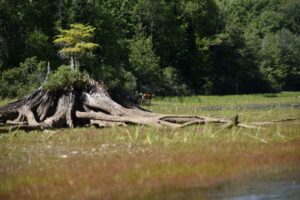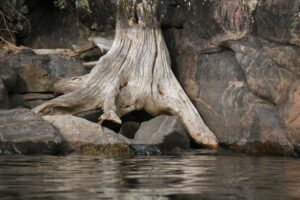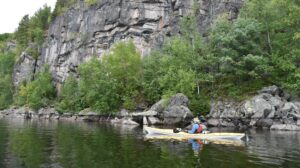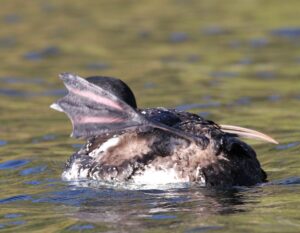NATURE ALTERS APACE, HUMANS RACE TO RUIN
Sliding quietly along the shoreline of a lake created 12,000 years ago, when the last Ice Age retreated, brings the difference between change caused by natural process, and that wreaked by human folly, into baffling focus.
When the forces of Nature reshape the world they create things that even when stark, are beautiful. When humanity does the same, it’s more often than not ugly destruction, no matter how you look at it.
The stump of a once towering white pine felled by age, a violent storm or the weight of ice and snow, can take years, perhaps decades, to rot away.

In the process, it’s a nursery for a windblown seed to take root and become a sprout of new growth.
Imagine the odds of that happening. And yet, it did.
That’s the process of natural change, a version of taking with one hand and giving with the other.
Now try to calculate a similar small miracle occurring in the unnatural, relentless changes being wrought on Gaza. According to an estimate by the UN Environment Programme, each square meter of the tormented territory contains an average of 107 kilograms of debris that includes asbestos, unexploded ordnance, human remains and the toxins released by weaponry.
And that was calculated a year ago. A UN survey in July this year, concluded that: “More than 86 per cent of cropland is damaged, while 12.4 per cent is undamaged but out of reach”, and likely to remain so as long as the fighting continues.
That leaves just short of 1.5 percent of Gaza, roughly 200 hectares, directly available to feed more than 2 million people, who prior to the war were mainly self-sufficient in fruit, vegetables and chicken.
PRICE TAGS
Fifty years after the Viet Nam war ended, civilians in that ravaged land, as well as those in Laos and Cambodia, are still being killed and maimed by unexploded ordnance and suffering the lasting effects of herbicides like Agent Orange, a chemical designed to obliterate crops and natural foliage.
Efforts to clear unexploded American munitions and landmines and a rehabilitation program for war victims have been halted, courtesy of the Trump administration’s slash and burn of USAID.
 This 1960s anti-war poster sums it up in a single line. The remnants left by continual war between the forces of weather and aging also last for decades.
This 1960s anti-war poster sums it up in a single line. The remnants left by continual war between the forces of weather and aging also last for decades.
But as the roots of ancient white pines fade and bleach, they become natural art.
Ift his one was given a clever title and an unconscionably high price tag,  it’s a fair bet a big name art auction house could sell it to someone who’d buy it just for the bragging rights of owning it, and no idea that the time-weathered stump is priceless, but only where it is now.
it’s a fair bet a big name art auction house could sell it to someone who’d buy it just for the bragging rights of owning it, and no idea that the time-weathered stump is priceless, but only where it is now.
The price tag for reclaiming (or obtaining in the eyes of some) the ruins of Gaza will be record-setting, but so far the only plan for it is what amounts to a crime under international law: displacing whatever residents are still alive when the war is over, and transforming the ruins into a “Riviera” only the crass and the tasteless would find appealing.
The products of natural transformation, on the other hand, are more often than not worthy of that overworked adjective, awesome.
 And yet, puny though we are in comparison, instead of spending time and resources figuring out how not to, we’re doing our utmost to reduce both the natural world and our place in it.
And yet, puny though we are in comparison, instead of spending time and resources figuring out how not to, we’re doing our utmost to reduce both the natural world and our place in it.
Being prepared for and fighting wars, for example, is a significant contributor to global warming.
The Conflict and Environment Observatory (CEOBS), which monitors the environmental dimensions of armed conflicts and military activities, calculated that “the total military carbon footprint is approximately 5.5% of global emissions.” If the world’s militaries were a country, it would have “the fourth largest national carbon footprint in the world.”
One enduring symbol from this part of the world, which leaves no print of any kind, is the loon, whose feet are so far back it cannot walk on land, but can swim and fly so well they never need to bother.
Theories on why they frequently raise one foot include stretching, cooling off and part of their preening process.
An appealing fourth possibility is to imagine it as one of “flipping the bird” at the timeless idiocy of humanity.
Comments are welcomed. Click CONTACT on the site header.
To receive e‑mail alerts to new posts, Click SIGN-UP on the header.